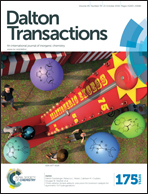Lanthanide coordination frameworks constructed from 3,3′,4,4′-diphenylsulfonetetracarboxylic and 1,10-phenanthroline: synthesis, crystal structures and luminescence properties†
Abstract
Two series of lanthanide coordination polymers, [Ln(Hdpstc)(H2O)2]n·nH2O (Ln = Sm (1), Eu (2), Gd (3), Tb (4), Dy (5), Ho (6), Er (7), Yb (8)) and [Ln(Hdpstc)(phen)(H2O)]n·1.5nH2O (Ln = Pr (9), Nd (10), Eu (11), Tb (12)) (H4dpstc = 3,3′,4,4′-diphenylsulfonetetracarboxylic acid and phen = 1,10-phenanthroline), have been hydrothermally synthesized and characterized by elemental analysis, IR and single crystal X-ray diffraction. Isostructural compounds 1–8 and 9–12 exhibit (3,6)-connected 2D layered structures with Hdpstc3− anions as bridges. The Eu3+ and Tb3+ compounds exhibit bright red and green emissions with absolute quantum yields of 11.19% for 2-Eu, 26.05% for 4-Tb, 35.74% for 11-Eu, and 48.05% for 12-Tb. With a rational design strategy, we have constructed a series of Tb3+-doped Eu3+ materials emitting tunable three primary colors towards efficient white light emission with compounds 2-Eu and 4-Tb, and the absolute quantum yield of white light emission is 13.58%. Meanwhile, 4-Tb displays a highly sensitive response toward Fe3+ ions through significant fluorescence quenching of Tb3+.


 Please wait while we load your content...
Please wait while we load your content...